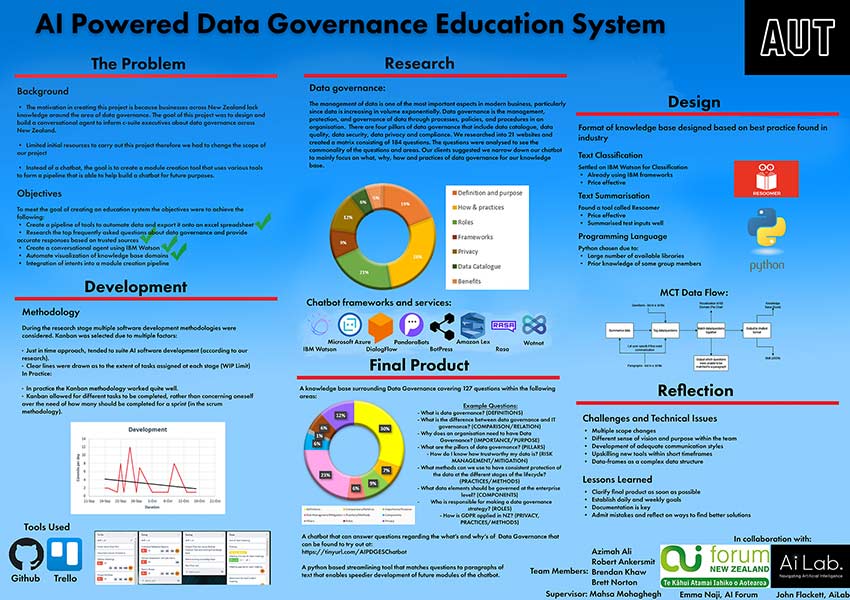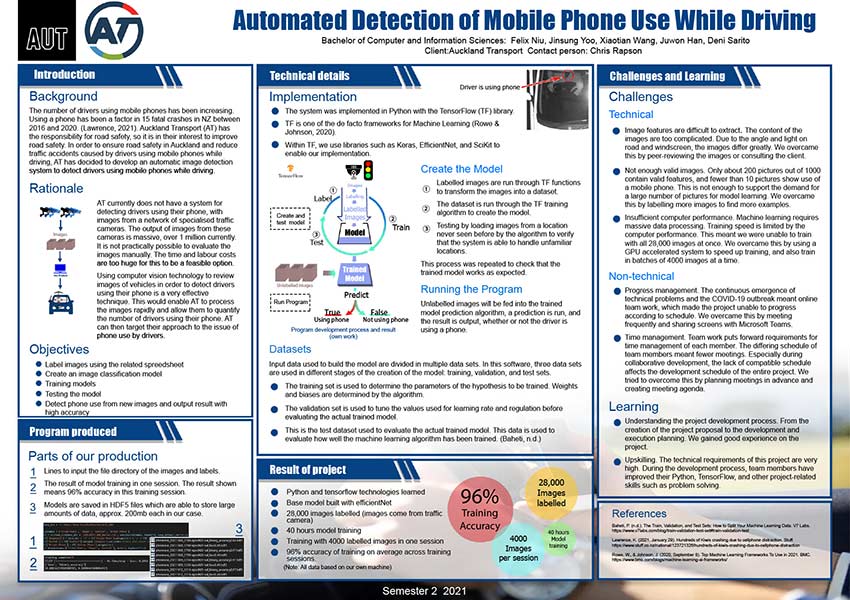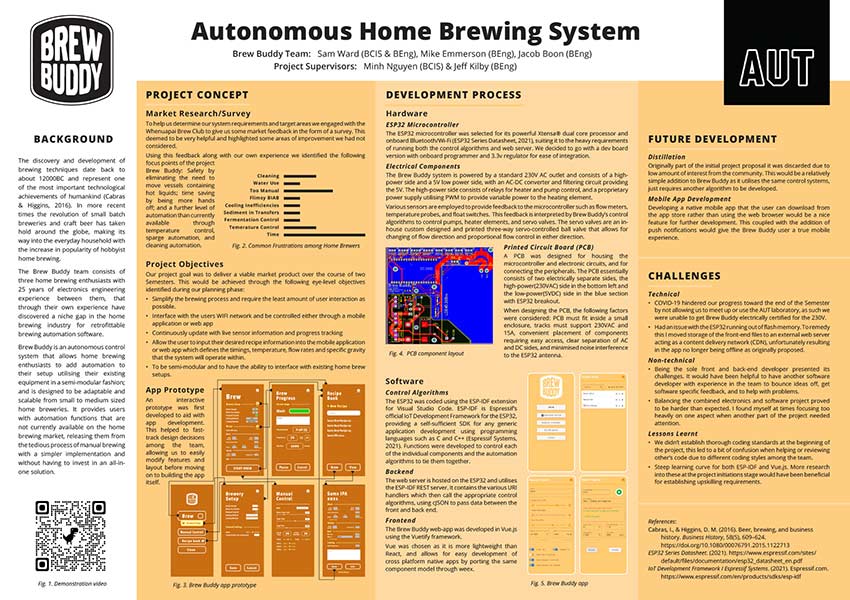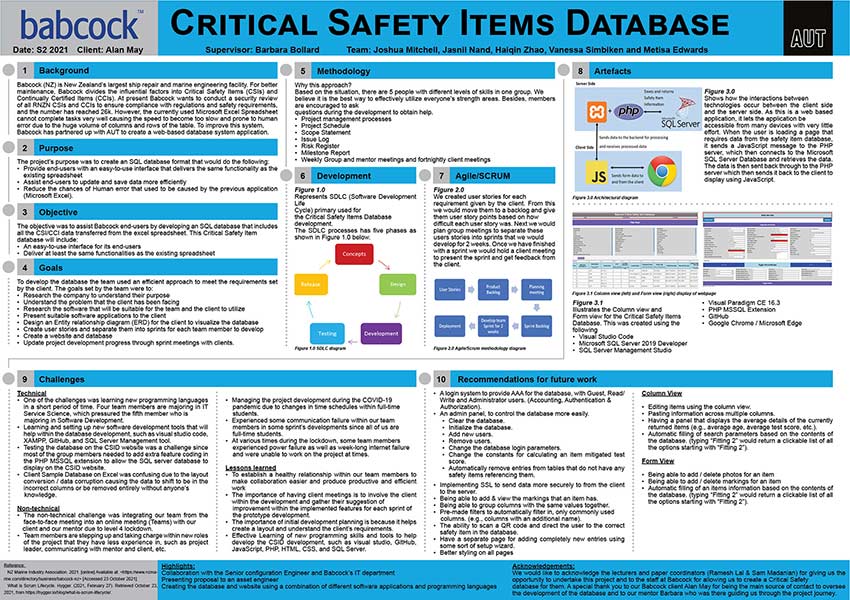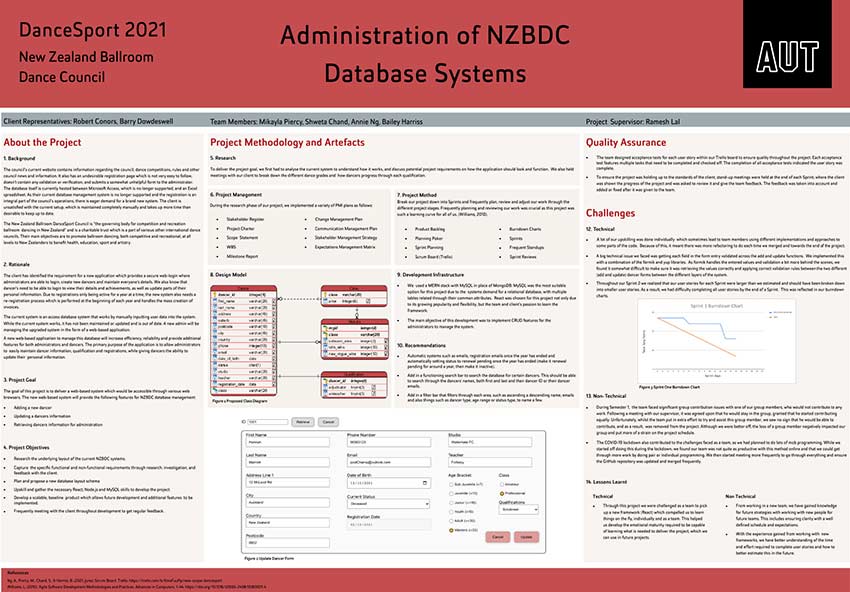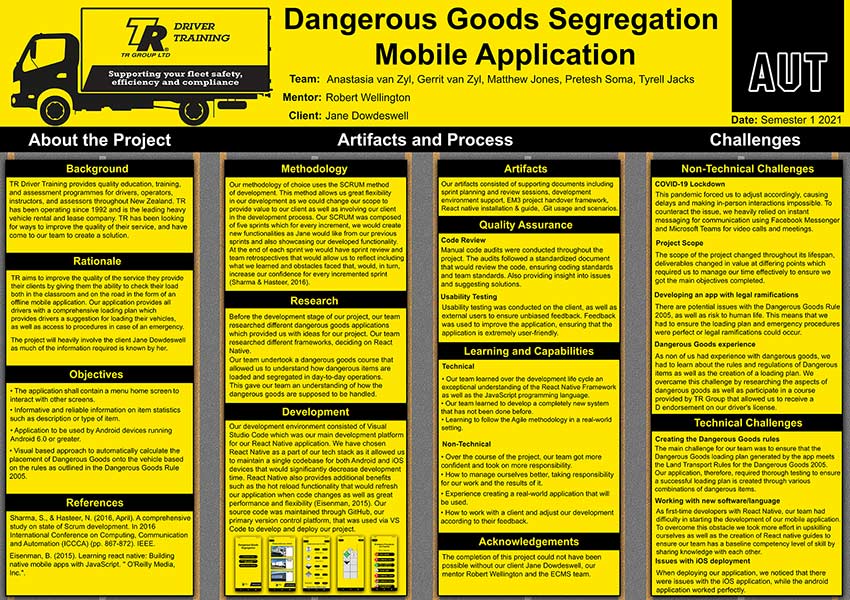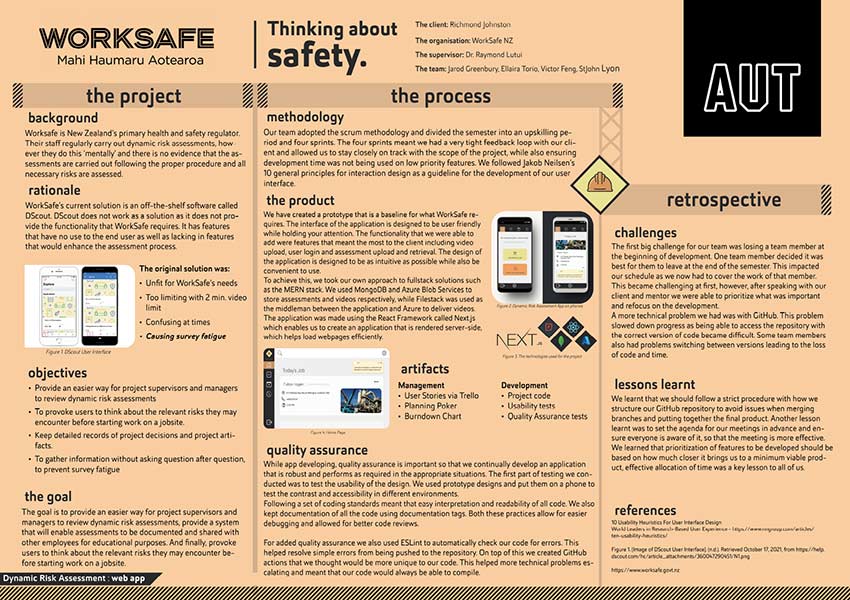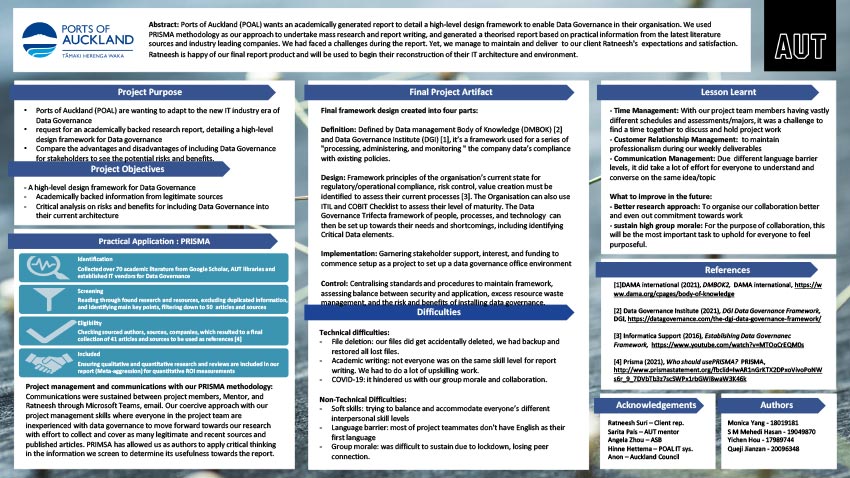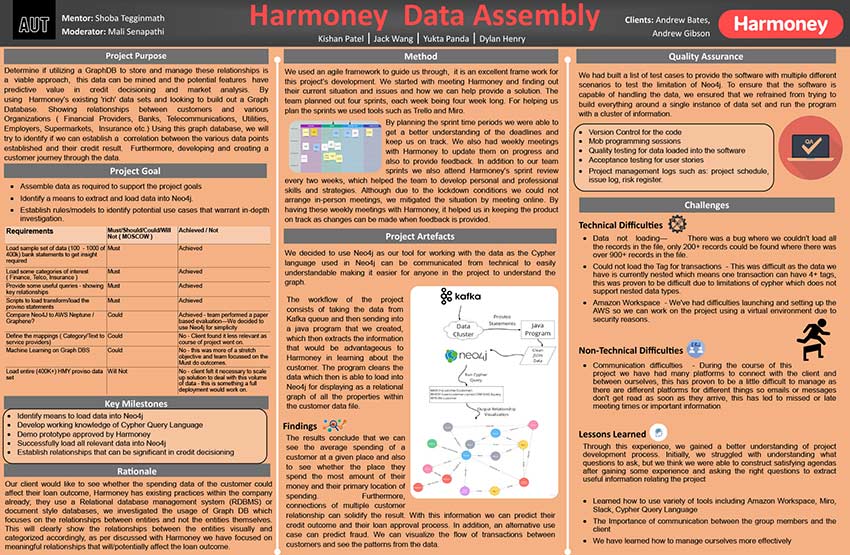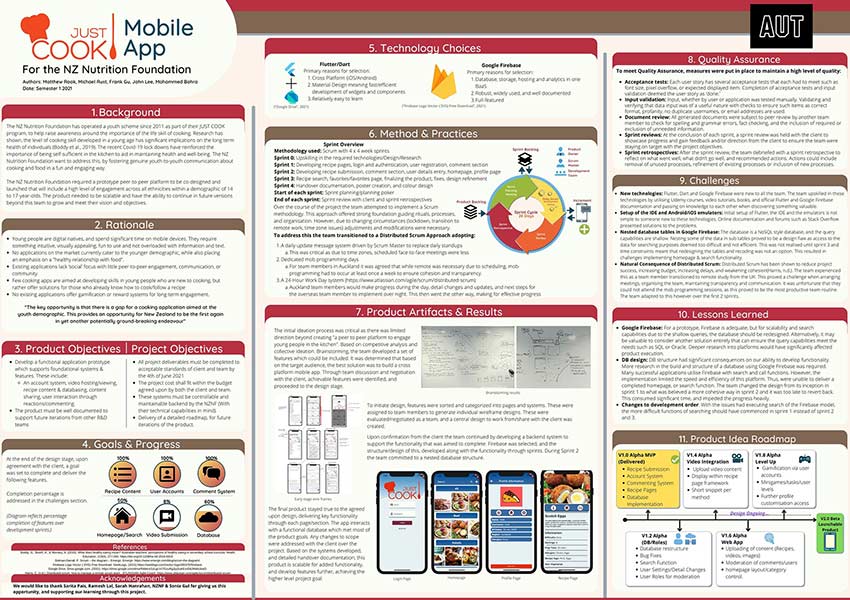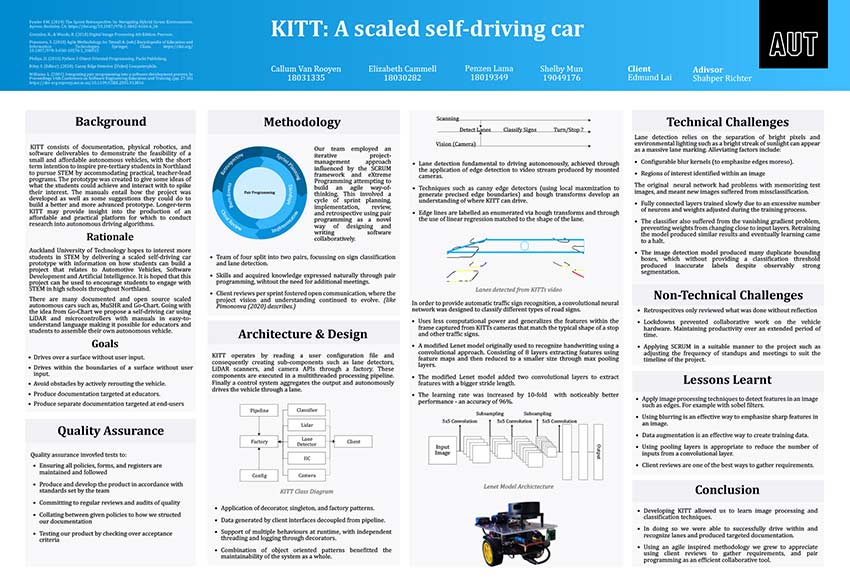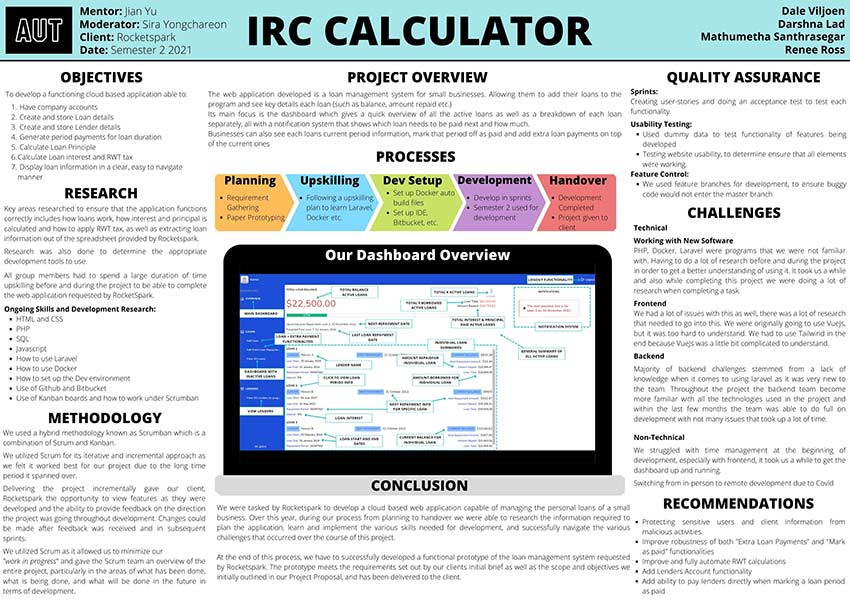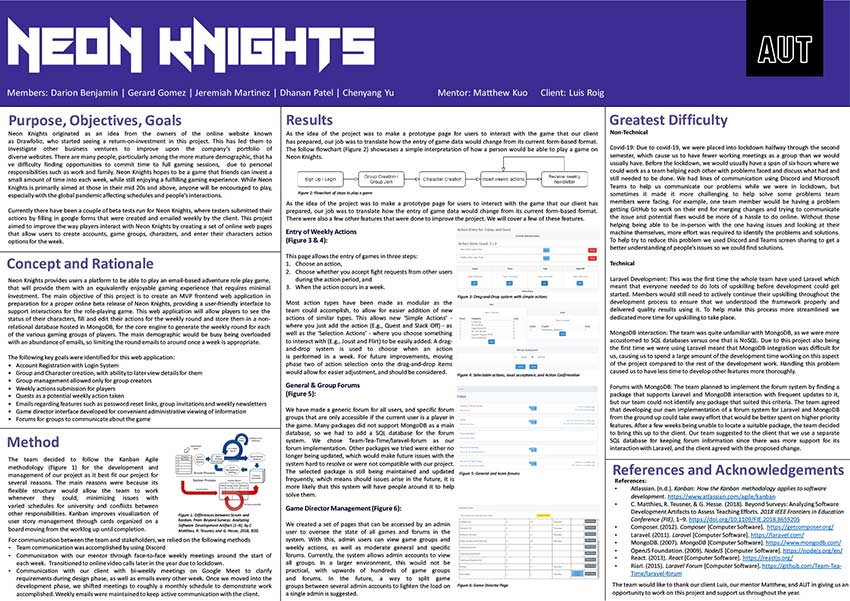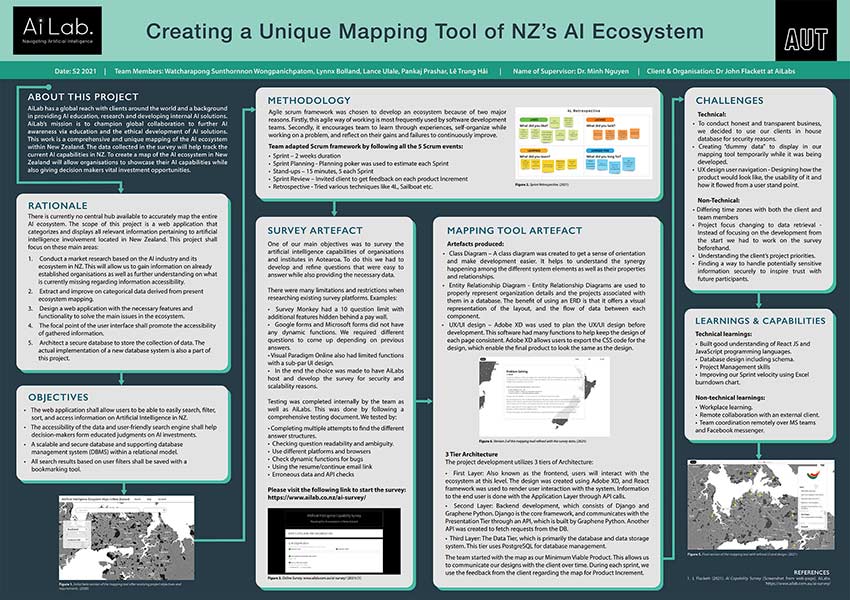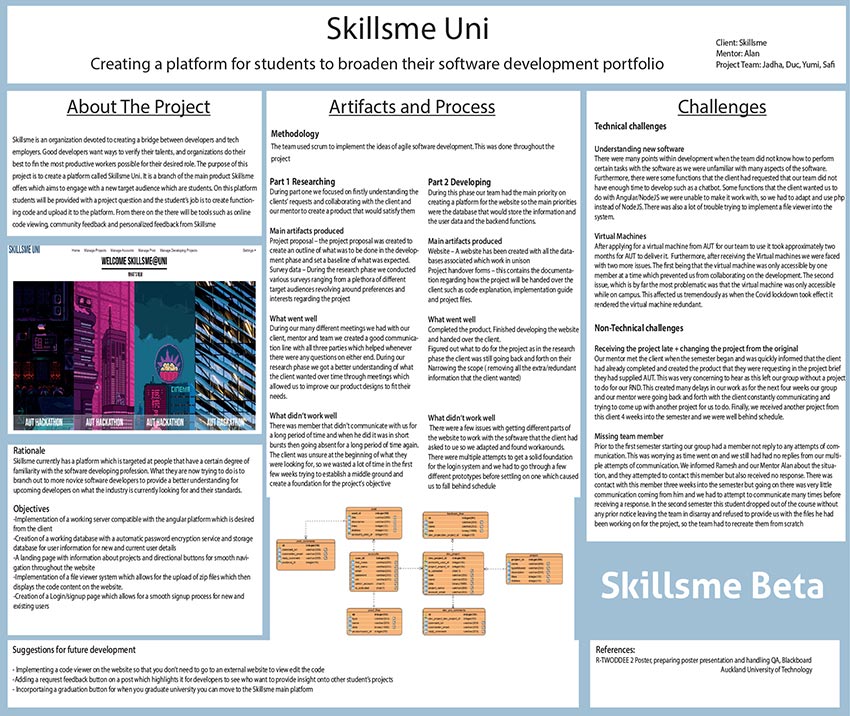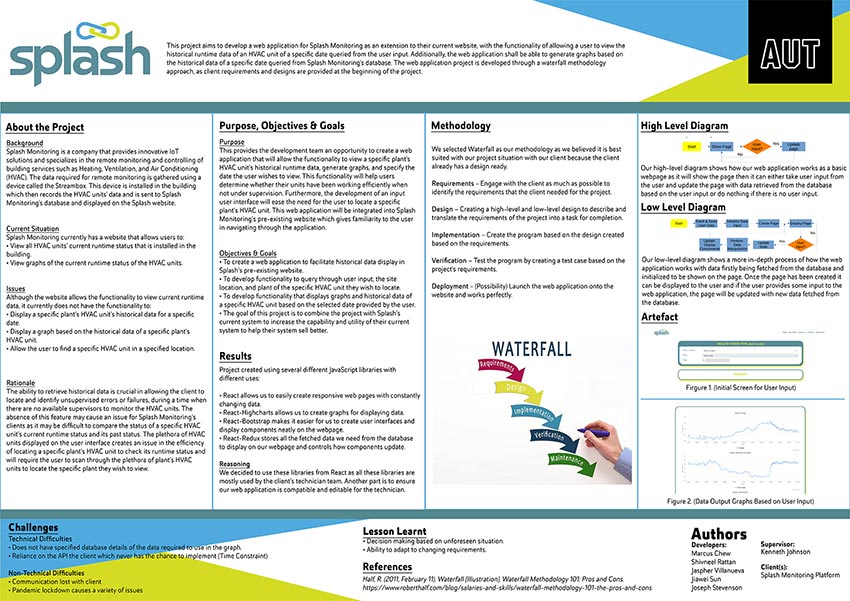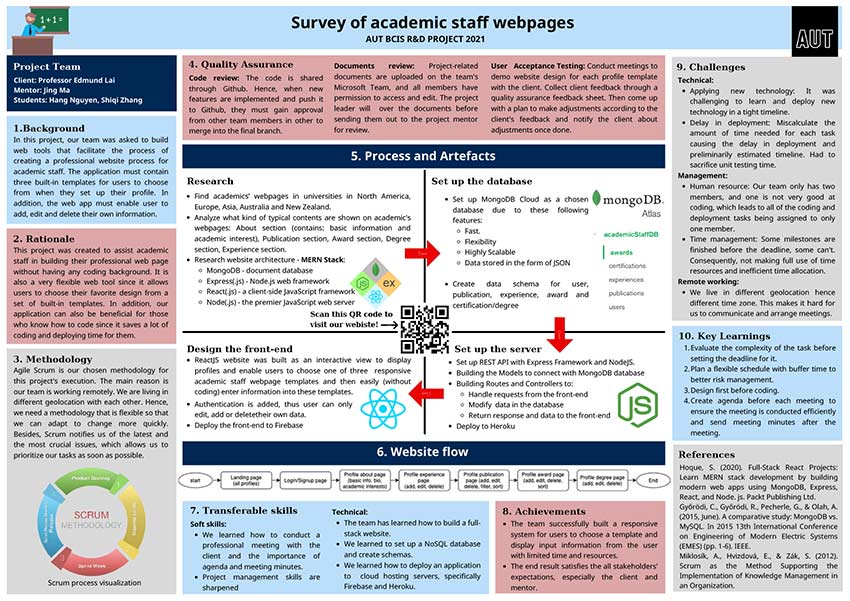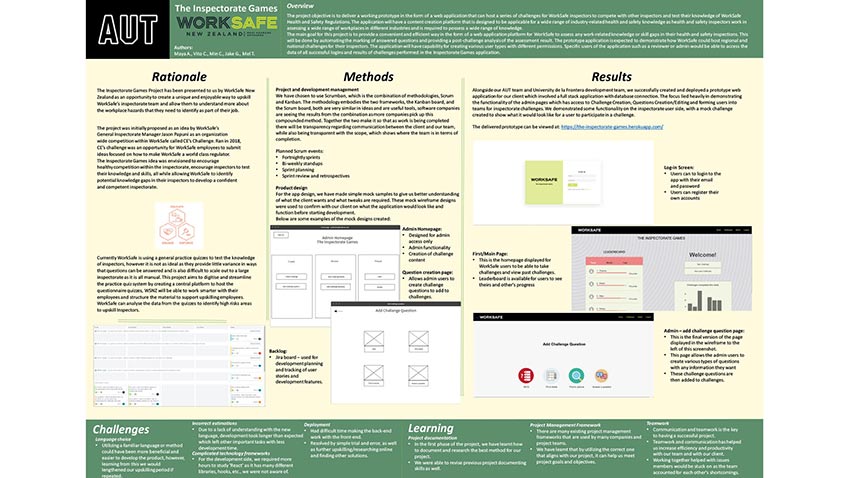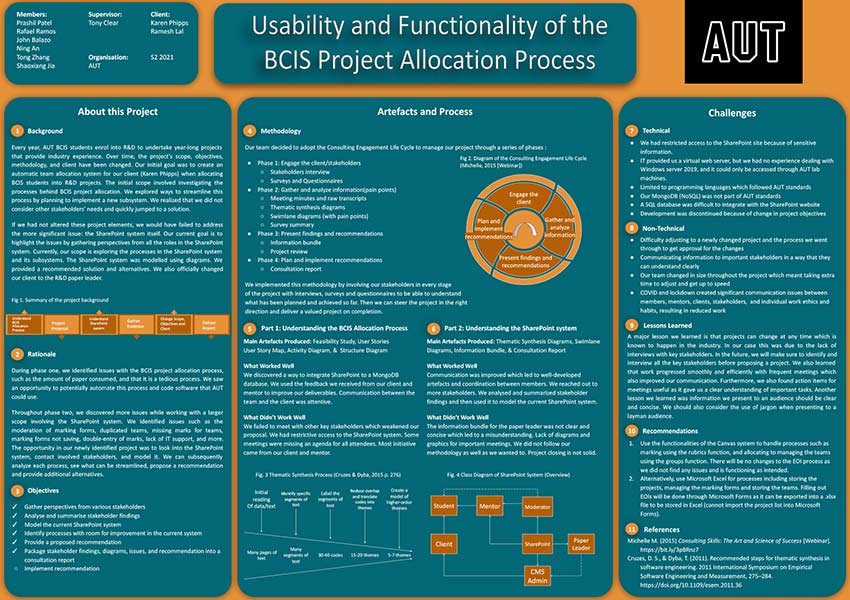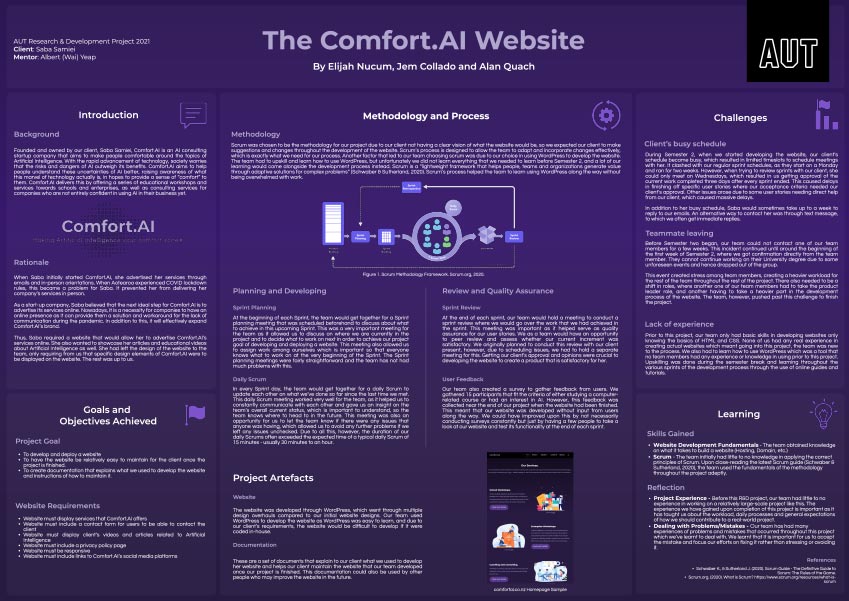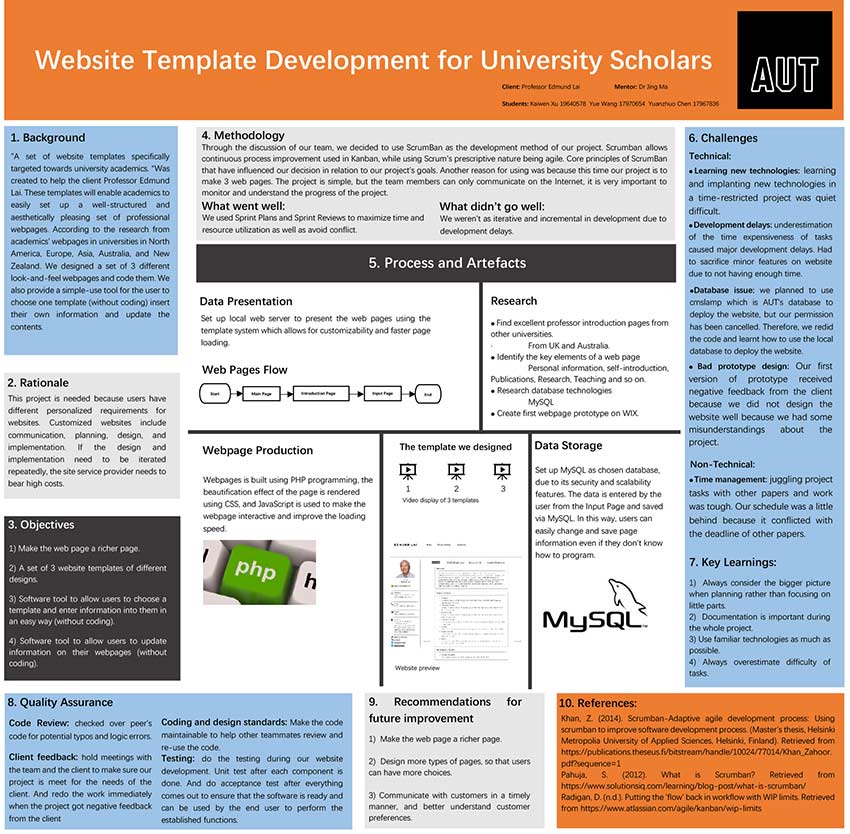Student showcase in Computer and Information Sciences 2021
Bachelor of Computer and Information Science students work on a real-life industry project as part of their final year in the areas of Software Development, Computer Sciences, Computational Intelligence, IT Service Science, Network and Security and Analytics. The course prepares our students for careers spanning from telecommunications to education and healthcare to finance.
We hope you enjoy the showcase and we encourage you to connect with our students through their LinkedIn profiles.
This project involved working with industry partners AI Lab and AI Forum to develop a way to educate people in the emerging field of data governance. To achieve this, the team developed a module creation tool that could be used to add additional modules to a knowledge base, which could then be used in the creation of a conversational agent using the IBM Watson framework. The module creation tool incorporates several functionalities to achieve this: text classification, text summarization, IBM Watson skill generation, manipulation of existing knowledge bases and the generation of pie charts consisting of domains the new module covers.
Student(s)
- Robert Ankersmit
Bachelor of Computer and Information Sciences - Azimah Ali
Bachelor of Computer and Information Sciences - Brett Norton
Bachelor of Computer and Information Sciences - Brendan Khaw
Bachelor of Computer and Information Sciences
Supervisor
- Mahsa Mohaghegh
Industry sponsor
- AI Lab and AI Forum
The aim of this project was to develop an automated system to detect drivers using their mobile phones by analyzing images captured from a traffic camera placed at several locations in Auckland. Our client, Auckland Transport (AT), trialled this specialized traffic camera to capture images through windscreens of vehicles. This enables gathering of statistics on when and where drivers are using phones. AT has received over 1 million images from these cameras in just a few months, far too many for humans to manually evaluate if drivers are using their phones. This is where Artificial Intelligence (AI) and Machine Learning (ML) come into play. Instead of humans viewing the images, an AI algorithm can analyse the images and output a result accordingly to if the driver is using their phone. We developed a training algorithm to train a model for this AI system. The training algorithm reads a spreadsheet where we have labelled images for driver using phone or not using phone, called the Ground Truth. The training algorithm also reads the corresponding image, and the algorithm repeats this many times to create the model. Once we have trained with a number of examples, we test the model with a completely new image the system has never seen before, to see the results. The model testing is crucial for the development of the program. This program we created is a prototype, and the client will further develop the application later on.
Student(s)
- Felix Niu
Bachelor of Computer and Information Sciences - Jinsung Yoo
Bachelor of Computer and Information Sciences - Juwon Han
Bachelor of Computer and Information Sciences - Deni Sarito
Bachelor of Computer and Information Sciences - Xiaotian Wang
Bachelor of Computer and Information Sciences
Supervisor
- Jing Ma
Mentor
- Professor Edmund Lai
Industry sponsor
- Auckland Transport
The discovery and development of brewing techniques date back to about 12000BC and represent one of the most important technological achievements of humankind (Cabras & Higgins, 2016). In more recent times the revolution of small batch breweries and craft beer has taken hold around the globe, making its way into the everyday household with the increase in popularity of hobbyist home brewing.The Brew Buddy team consists of three home brewing enthusiasts with 25 years of electronics engineering experience between them, that through their own experience have discovered a niche gap in the home brewing industry for retrofittable brewing automation software. Brew Buddy is an autonomous control system that allows home brewing enthusiasts to add automation to their setup utilising their existing equipment in a semi-modular fashion; and is designed to be adaptable and scalable from small to medium sized home breweries. It provides users with automation functions that are not currently available on the home brewing market, releasing them from the tedious process of manual brewing with a simpler implementation and without having to invest in an all-in-one solution.
Student(s)
- Sam Ward
Bachelor of Computer and Information Sciences and Bachelor of Engineering - Mike Emmerson
Bachelor of Engineering - Jacob Boon
Bachelor of Engineering
Supervisor
- Minh Nguyen
- Jeff Kilby
This poster presents the work that the CSID team have completed during the Research and Development course. The team have collaborated with Babcock NZ to produce a Critical Safety Items Database. The poster outlines the problem that Babcock NZ currently faces and the objectives and goals that have helped the team create a web based database for Babcock. The methodology that has been utilized in the project was Scrum/Agile methodology as it was suitable for this project, allowing the continuous approval in the development stages by the Client. The poster also exhibits the project artefacts, displaying the software used to create the web page and database. Finally, the poster highlights the challenges faced while undertaking the project and recommendations for future development to complete and improve the system that the CSID team have created.
Student(s)
- Joshua Mitchell
Bachelor of Computer and Information Sciences - Haiqin Zhao
Bachelor of Computer and Information Sciences - Jasnil Nand
Bachelor of Computer and Information Sciences - Vanessa Simbiken
Bachelor of Computer and Information Sciences - Metisa Edwards
Bachelor of Computer and Information Sciences
Supervisor
- Ramesh Lal
Industry sponsor
- Alan May, Babcock NZ
The New Zealand Ballroom DanceSport Council is “the governing body for competition and recreation ballroom dancing in New Zealand” and is a charitable trust which is a part of various other international dance councils. Their main objectives are to promote ballroom dancing, both competitive and recreational, at all levels to New Zealanders to benefit health, education, sport and artistry. We researched the underlying layout of the current system as well as any additional requirements so that we could build the new application from the ground up. The goal of this project is to deliver a web-based system which would be accessible through various web browsers. The new web-based system will provide CRUD features for NZBDC database management of their dancers. This project was developed with React, using a variation of the MERN stack, with MySQL in place of MongoDB, due to the need for a relatioal database.
Student(s)
- Mikayla Piercy
Bachelor of Computer and Information Sciences and Bachelor of Engineering - Shweta Chand
Bachelor of Engineering - Annie Ng
Bachelor of Engineering - Bailey Harriss
Bachelor of Engineering
Supervisor
- Ramesh Lal
Mentors
- Robert Conors
- Barry Dowdeswell
Industry sponsor
- New Zealand Ballroom Dance Council
The purpose of this project is to build a mobile application for our client Jane Dowdeswell who represents TR Group. The application’s purpose is to allow truck drivers and loaders to segregate Dangerous goods with the intent of creating a safe loading plan as specified by the Land Transport Act 2005. This program has many features and functionalities including, the ability to automatically create a loading plan for the user through rules and regulations, information about special circumstances of dangerous items and also contains an emergency procedures guide with instructions on what to do in an emergency situation. This application is a first of a kind as we ourselves have taken the Dangerous Goods endorsement course provided by TR Group and can see the value this would provide to eliminate human error and keep truck drivers safe.
Student(s)
- Gerrit van Zyl
Bachelor of Computer and Information Sciences - Pretesh Soma
Bachelor of Computer and Information Sciences - Anastasia Van Zyl
Bachelor of Computer and Information Sciences - Matthew Jones
Bachelor of Computer and Information Sciences - Tyrell Jacks
Bachelor of Computer and Information Sciences
Mentor
- Robert Wellington
Industry sponsor
- TR Group
The ‘Digital Human’ is a proof-of-concept solution that demonstrates how AI and cognitive services can be used to help enhance clinician workflows at the Auckland District Health Board’s Greenlane clinic. This was a collaborative effort that was formed by Deloitte and the Auckland District Health Board (ADHB). Deloitte is a multinational professional services network that guided the team in both the consulting and engineering aspects of the project. The ADHB is the New Zealand government’s funder and provider of health services to residents living in Auckland. They were also the primary client of this project in which the solution was being developed for.The initial scope of the project was deliberately left undefined to allow the team to journey through the entire consulting and development process - from initial scoping and requirements gathering to development and handover. Through the guidance and support of Deloitte professionals, and several consultations with medical practitioners from the ADHB, the team were able to identify an opportunity to rework the existing Resident Medical Officer (RMO) handbook. This is a digitized handbook that RMO’s access in the form of a mobile application to help with their decision making regarding common medical problems. By consulting with RMO’s, the team were able to identify several pain-points they have with the current mobile application, as well as discover its possible future state.The team were therefore assigned with the task to develop a proof-of-concept solution that demonstrates a new and improved way to interact with the RMO handbook. This was achieved by developing a React-Native mobile application that leverages several cloud technologies from Amazon Web Services such as Lex, Kendra & Comprehend Medical. Deloitte’s 4D framework was also incorporated in delivering the solution. This essentially breaks the project down into four distinct phases – Discover, Define, Design and Deliver. The scrum framework was also utilized to help with development purposes.In the end, the team managed to successfully deliver a prototype solution that now serves as a basis for future medical problems that can be solved using technology. It will now also act as the starting point in producing the new and improved version of the RMO handbook.
Student(s)
- Jacob Garbarek
Bachelor of Computer and Information Sciences and Business (Conjoint) - Lolomanaia Saulala
Bachelor of Computer and Information Sciences and Business (Conjoint) - Ben Henshall
Bachelor of Computer and Information Sciences - Adhay Vraich
Bachelor of Computer and Information Sciences - Malan Gunaratne
Bachelor of Computer and Information Sciences
Supervisor
- Sam Madanian
Industry sponsor
- Deloitte
Worksafe is New Zealand’s primary health and safety regulator. Their staff regularly carry out dynamic risk assessments, however they do this ‘mentally’ and there is no evidence that the assessments are carried out following the proper procedure and all necessary risks are assessed. WorkSafe’s current solution is an off-the-shelf software called DScout. DScout does not work as a solution as it does not provide the functionality that WorkSafe requires. It has features that have no use to the end user as well as lacking in features that would enhance the assessment process. Provide an easier way for project supervisors and managers to review dynamic risk assessments. Provide a system that will enable assessments to be documented and shared with other employees for educational purposes. To provoke users to think about the relevant risks they may encounter before starting work on a jobsite. Provide an easier way for project supervisors and managers to review dynamic risk assessments. Provide a system that will enable assessments to be documented and shared with other employees for educational purposes. To provoke users to think about the relevant risks they may encounter before starting work on a jobsite. We have created a prototype that is a baseline for what WorkSafe requires. The interface of the application is designed to be user friendly while holding your attention. The functionality that we were able to add were features that meant the most to the client including video upload, user login and assessment upload and retrieval. The design of the application is designed to be as intuitive as possible while also be convenient to use. To achieve this, we took our own approach to fullstack solutions such as the MERN stack. We used MongoDB and Azure Blob Services to store assessments and videos respectively, while Filestack was used as the middleman between the application and Azure to deliver videos. The application was made using the React Framework called Next.js which enables us to create an application that is rendered server-side, which helps load webpages efficiently. While app developing, quality assurance is important so that we continually develop an application that is robust and performs as required in the appropriate situations. The first part of testing we conducted was to test the usability of the design. We used prototype designs and put them on a phone to test the contrast and accessibility in different environments. Following a set of coding standards meant that easy interpretation and readability of all code. We also kept documentation of all the code using documentation tags. Both these practices allow for easier debugging and allowed for better code reviews. For added quality assurance we also used Babel ESLint to automatically check our code for errors. This helped resolve simple errors from being pushed to the repository. On top of this we created GitHub actions that we thought would be more unique to our code. This helped more technical problems escalating and meant that our code would always be able to compile. The first big challenge for our team was losing a team member at the beginning of development. One team member decided it was best for them to leave at the end of the semester. This impacted our schedule as we now had to cover the work of that member. This became challenging at first, however, after speaking with our client and mentor we were able to prioritize what was important and refocus on the development. A more technical problem we had was with GitHub. This problem slowed down progress as being able to access the repository with the correct version of code became difficult. We learnt that we should follow a strict procedure with how we structure our GitHub repository to avoid issues when merging branches and putting together the final product. Another lesson learnt was to set the agenda for our meetings in advance and ensure everyone is aware of it, so that the meeting is more effective. We learned that prioritization of features to be developed should be based on how much closer it brings us to a minimum viable product, effective allocation of time was a key lesson to all of us.
Student(s)
- Victor Feng
Bachelor of Computer and Information Sciences and Business (Conjoint) - Ellaira Torio
Bachelor of Computer and Information Sciences and Business (Conjoint) - St John Lyon
Bachelor of Computer and Information Sciences - Jarod Greenbury
Bachelor of Computer and Information Sciences
Mentor
- Dr Raymond Lutui
Ports of Auckland (POAL) are wanting to adapt to the new IT industry era of Data Governancerequest for an academically backed research report, detailing a high-level design framework for Data governanceCompare the advantages and disadvantages of including Data Governance for stakeholders to see the potential risks and benefits.- A high-level design framework for Data GovernanceAcademically backed information from legitimate sourcesCritical analysis on risks and benefits for including Data Governance into their current architecture.
Student(s)
- Monica Yang
Bachelor of Computer and Information Sciences - Mehedi Hasan
Bachelor of Computer and Information Sciences - Yichen Hou
Bachelor of Computer and Information Sciences - Queji Jianzan
Bachelor of Computer and Information Sciences - Deni Sarito
Bachelor of Computer and Information Sciences - Xiaotian Wang
Bachelor of Computer and Information Sciences
Mentor
- Sarita Pais
Industry sponsor
- Ports of Auckland
Determine if utilizing a GraphDB to store and manage these relationships is a viable approach, this data can be mined and the potential features have predictive value in credit decisioning and market analysis. By using Harmoney’s existing 'rich' data sets and looking to build out a Graph Database. Showing relationships between customers and various Organizations ( Financial Providers, Banks, Telecommunications, Utilities, Employers, Supermarkets, Insurance etc.) Using this graph database, we will try to identify if we can establish a correlation between the various data points established and their credit result. Furthermore, developing and creating a customer journey through the data.
Student(s)
- Kishan Patel
Bachelor of Computer and Information Sciences and Business (Conjoint) - Jack Wang
Bachelor of Computer and Information Sciences and Business (Conjoint) - Yukta Panda
Bachelor of Computer and Information Sciences - Dylan Henry
Bachelor of Computer and Information Sciences
Mentor
- Shoba Tegginmath
Industry sponsor
- Harmoney
During the recent lockdown due to COVID-19, it was shown thatknowing how to cook and feed ourselves makes a big difference to maintaining health and wellbeing.Specifically,young people need to be able to learn the valuable life skill of cooking and be able to be more and more self-sufficient in the kitchen, relying less on ready-made mealsor fast food. Paragon Solutions believe that the solution to this problem is develop the Youth Food Movement project. A digital online learning platform that is not only fun and engaging but will inspire and motivate the young people of New Zealand to get in the kitchen and cook food that they want to create and eat.
Student(s)
- Mohammed Bohra
Bachelor of Computer and Information Sciences and Business (Conjoint) - Matthew Rook
Bachelor of Computer and Information Sciences and Business (Conjoint) - Michael Rust
Bachelor of Computer and Information Sciences - John Lee
Bachelor of Computer and Information Sciences - Fan Gu
Bachelor of Computer and Information Sciences
Supervisor
- Sarita Pais
Industry sponsor
- The New Zealand Nurition Foundation
KITT is a scaled autonomous vehicle that provides an approachable platform to demonstrate and research methods relating to the self-driving capabilities of cars. Our research focused on the application of lane and object detection to drive a purpose-built robotic vehicle within marked lanes without human intervention. Ultimately, we present a pipeline that accumulates the coordinates of nearby 3D obstacles, visual segmentation of lanes, and traffic sign recognition to control the vehicle’s electric motors based on the relative position to the center of an indoor road. The pipeline runs on an embedded platform mounted to a prototype acrylic chassis and makes use of the optimized image processing routines provided in OpenCV to run multiple threads in real-time, that are finally synchronized through a control system designed to overcome any veering motion. Automatic detection of lanes and obstacles are achieved through the application of Canny edge detection, Hough transforms, and artificial neural networks whilst various sensors such as LiDARs and microcontrollers are polled continuously over serial protocols. KITT aims to prove the applicability of approachable autonomous vehicles in education and academic research and inspire pre-tertiary students to pursue emerging fields in science and technology.
Student(s)
- Callum Van Rooyen
Bachelor of Computer and Information Sciences - Elizabeth Cammell
Bachelor of Computer and Information Sciences - Shelby Mun
Bachelor of Computer and Information Sciences - Penzen Lama
Bachelor of Computer and Information Sciences
Supervisor
- Edmund Lai
Mentor
- Shahper Richter
The web application developed is a loan management system for small businesses. Allowing them to add their loans to the program and see key details each loan (such as balance, amount repaid etc.) Its main focus is the dashboard which gives a quick overview of all the active loans as well as a breakdown of each loan separately, all with a notification system that shows which loan needs to be paid next and how much.Businesses can also see each loans current period information, mark that period off as paid and add extra loan payments on top of the current ones.
Student(s)
- Dale Viljoen
Bachelor of Computer and Information Sciences - Renee Ross
Bachelor of Computer and Information Sciences - Mathumetha Santhrasegar
Bachelor of Computer and Information Sciences - Darshna Lad
Bachelor of Computer and Information Sciences
Supervisor
- Jian Yu
Mentor
- Sira Yongchareon
Industry sponsor
- Rocketspark
A web app to collect information given by players about the actions they would like their characters to take over any week. Also includes a forum system, and admin pages, stretch goals that we were able to implement.
Student(s)
- Darion Benjamin
Bachelor of Computer and Information Sciences - Gerard Gomez
Bachelor of Computer and Information Sciences - Jeremiah Martinez
Bachelor of Computer and Information Sciences - Dhanan Patel
Bachelor of Computer and Information Sciences - Chenyang Yu
Bachelor of Computer and Information Sciences
This project aims to map the current level of Artificial Intelligence capabilities across New Zealand. Using a variety of research methods, this research will identify companies, institutions and projects that make use of AI-based tools and techniques and the associated AI capabilities analysed. The collated AI capabilities will be mapped (categorised) to help drive informed decision making for AI investment, policies and strategies.
Student(s)
- Lance Ulale
Bachelor of Computer and Information Sciences - Hai Trung Le
Bachelor of Computer and Information Sciences - Pankaj Prashar
Bachelor of Computer and Information Sciences - Lynnx Bolland
Bachelor of Computer and Information Sciences - Win Wongpanichpatom
Bachelor of Computer and Information Sciences
The purpose of the project is to create a platform called Skillsme Uni. It came about because of a survey where the company asked its users what they are looking for from the platform. This branch of the product aims to engage with a new target audience. This being students that are studying to enter the industry. This is a key demographic to target as it increases the user base, while also serving as a pipeline for future workers to use the core site for work opportunities. With this idea comes many key requirements and deliverables that will need to be created within the coming months. The platform will expand on the already utilised theme of knowledge collaboration.
Student(s)
- Safi Qureshi
Bachelor of Computer and Information Sciences - Duc Dao
Bachelor of Computer and Information Sciences - Xiaoqi Chai
Bachelor of Computer and Information Sciences - Jadha Mackay
Bachelor of Computer and Information Sciences
Supervisor
- Stephen Thorpe
Mentor
- Alan Litchfield
Industry sponsor
- Skillsme
Develop a web application for Splash Monitoring Platform. This web application contains the functionality that allows a user to select a specific date to view historical data in the form of a graph of a specific plant’s Heating, Ventilation and Air Conditioning unit (HVAC), so that the user can view runtime status of a HVAC unit that is not supervised.
Student(s)
- Marcus Chew Chee Woon
Bachelor of Computer and Information Sciences - Jaspher Villanueva
Bachelor of Computer and Information Sciences - Shivneel Rattan
Bachelor of Computer and Information Sciences - Joseph Stevenson
Bachelor of Computer and Information Sciences - Jiawei Sun
Bachelor of Computer and Information Sciences
Supervisor
- Ramesh Lal
Mentor
- Kenneth Johnson
Industry sponsor
- Splash Monitoring Platform
In this project, our team was asked to buildweb tools that facilitate the process ofcreating a professional website process foracademic staff. The application must containthree built-in templates for users to choosefrom when they set up their profile. Inaddition, the web app must enable user toadd, edit and delete their own information.
Student(s)
- Hang Nguyen
Bachelor of Computer and Information Sciences - Shiqi Zhang
Bachelor of Computer and Information Sciences
Supervisor
- Jing Ma
Mentor
- Professor Edmund Lai
The project objective is to deliver a working prototype in the form of a web application that can host a series of challengesfor WorkSafe inspectors to compete with other inspectors and test their knowledge of WorkSafe Health and Safety Regulations, by the end of week 12 in semester 2. As confirmed with the client, the application will have a content creation platform that is designed to be applicable fora wide range of industry-related health and safety knowledge. This is because health and safety inspectors work in assessing a wide range of workplaces in different industries andneed to possess a wide range of knowledge.The main goal for this project is to provide a convenient and efficient way in the form of a web application platform for WorkSafe to assess any work-related knowledge or skill gaps in their Health and Safety Inspectors.This will be done by automating the marking of answered questions and providing a post-challenge analysis of the assessment result.The prototype application is expected to demonstrate how WorkSafe could host regional and national challenges for their inspectors. The application will have capability for creating various user types with different permissions. Specific users of the application such as a reviewer or admin would be able to access the data of all successful logins and results of challenges performed in the Inspectorate Games application.
Student(s)
- Maya Ashizumi-Munn
Bachelor of Computer and Information Sciences - Vito Cheng
Bachelor of Computer and Information Sciences - Jake Gardner
Bachelor of Computer and Information Sciences - Min Chun
Bachelor of Computer and Information Sciences - Mel Toa
Bachelor of Computer and Information Sciences
Supervisor
- Ricardo Chacon Mestre
Mentor
- Sam Madanian
Industry sponsor
- WorkSafe
Every year, BCIS students enrol into R&D to undertake year-long projects that provide industry experience. The aim of this project is to investigate the processes behind the R&D paperthrough interviews with key roles. From our findings, we modelled the current system and outlined processes with issues and potential for improvement. Finally, we came up with recommendations in a form of a consultation report in hopes to highlight the problems and provide solutions.
Student(s)
- Prashil Patel
Bachelor of Computer and Information Sciences and Business (Conjoint) - Rafael Ramos
Bachelor of Computer and Information Sciences and Business (Conjoint) - John Balazo
Bachelor of Computer and Information Sciences - Ning An
Bachelor of Computer and Information Sciences - Shaoxiang Jia
Bachelor of Computer and Information Sciences - Tong Zhang
Bachelor of Computer and Information Sciences
Supervisor
- Ramesh Lal
Mentor
- Tony Clear
Comfort.AI is a start-up company owned by our client Saba Samiei with the purpose of making people feel comfortable with Artificial Intelligence. There aim is to provide people with knowledge and educate them so that they can form their own opinions about AI. The goal of this project was to develop and deploy a website for our client in order to advertise Comfort.AI’s services as well as promote her article posts and educational videos. The website also allows people to contact our client through a contact form on the website regarding the company’s services.
Student(s)
- Alan Quach
Bachelor of Computer and Information Sciences - Elijah Nucum
Bachelor of Computer and Information Sciences - Jemuel Collado
Bachelor of Computer and Information Sciences
Supervisor
- Stephen Thorpe
Mentor
- Albert (Wai) Yeap
Industry sponsor
- Comfort.AI
A set of website templates specifically targeted towards university academics. “Was created to help the client Professor Edmund Lai. These templates will enable academics to easily set up a well-structured and aesthetically pleasing set of professional webpages. According to the research from academics’ webpages in universities in North America, Europe, Asia, Australia, and New Zealand. We designed a set of 3 different look-and-feel webpages and code them. We also provide a simple-use tool for the user to choose one template (without coding) insert their own information and update the contents.
Student(s)
- Kaiwen Xu
Bachelor of Computer and Information Sciences - Yue Wang
Bachelor of Computer and Information Sciences - Yuanzhuo Chen
Bachelor of Computer and Information Sciences
Supervisor
- Jing Ma
Mentor
- Professor Edmund Lai
Partnering with industry
AUT is proud of its strong industry links and we are always looking for new opportunities to partner with organisations. If you have any feedback or are interested in submitting a project for next year please contact the Industry Advisory for BCIS: Karen Phipps.
Student works from other areas
AUT’s degrees in engineering, computer and mathematical sciences are an opportunity for our students to play a key role in New Zealand’s technological, social and economic development.
We are proud and excited to display the work of our final year students and we invite you to celebrate with us their fantastic achievements.
